Residents continue recovery efforts six months after Hurricane Ian
Shortly after Hurricane Ian made landfall on the Southwest Florida coast Sept. 28, 2022, Kathy Armstrong and her husband Jim Shatford returned from Nova Scotia to find their seasonal home at Holiday Park – an 836-residence retirement community in North Port – severely damaged.
Nearly six months later, the Canadian snowbird said the residents who returned have been doing their best to piece together their lives and find joy in the little things – like dances hosted outside and group picnics, because the main clubhouse is out of commission.
“We’re still mitigating some of the damage that Ian has bestowed upon us,” Armstrong said.
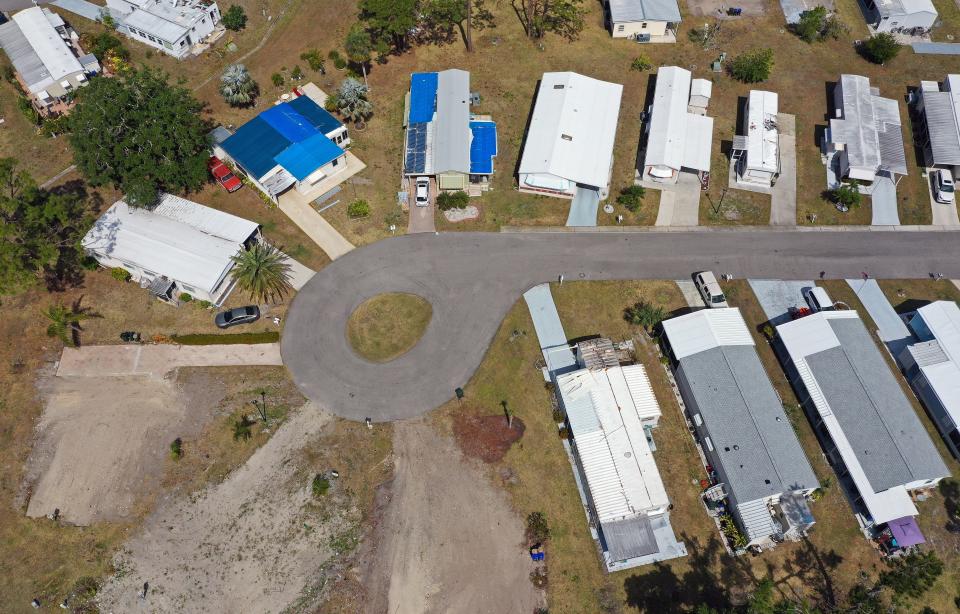
A federal report ranked Hurricane Ian as the third most costly in the U.S., behind Katrina in 2005 and Harvey in 2017, after causing nearly $113 billion in damage and 152 deaths.
“When you’re hit directly by a generational storm like Hurricane Ian the challenges are abundant,” said John Mills, a Federal Emergency Management Agency spokesman.
Some figures at the six-month anniversary of Hurricane Ian's arrival give some sense of the scope of the ongoing recvoery:
More than $1 billion in assistance has been paid out to 384,600 households statewide, according to the latest FEMA figures available.
Earlier:Hurricane Ian brought wind and rain but Sarasota-Manatee spared from major storm surge
$3.2 billion in National Flood Insurance Program funds have been paid to cover about 46,000 flood claims.
More than 4,560 households have sought transitional sheltering assistance through FEMA.
Statewide 1,324 households are still living in emergency housing directly paid for by FEMA – either hotels or apartments and mobile homes. Of those, 532 are in Lee County, 205 in Charlotte County, 126 in Sarasota County, 94 in Collier County, 49 in DeSoto County and 11 in Manatee County.
“People are going through some traumatic decision-making processes,” Mills noted. “People may be trying to decide how to rebuild or whether to rebuild – because of the flood-prone nature of the area, because of the high likelihood that another hurricane may hit as soon a this year; some people may choose to relocate and the money they’ve received can be used to relocate out of harm’s way.”
Big expense:North Port to revisit charging Ian victims $27,000 to reconnect to water and sewer service
North Port community: A marvel of resiliency
The rebuilding of the 55-and-over Holiday Park manufactured home community, which briefly gained national notoriety as the city of North Port worked out a way to avoid onerous water service charges for empty homes, will change the neighborhood's character for years to come.
“It's funny, I was just saying to my husband this morning, when we come back next year, after they finish all the demolition, we’ll be living in a field – the place across from us is destroyed, the place beside us is destroyed, the place behind us has been destroyed,” Armstrong said. “Where we’re pretty close to our neighbors before, we’re not close to our neighbors anymore.”
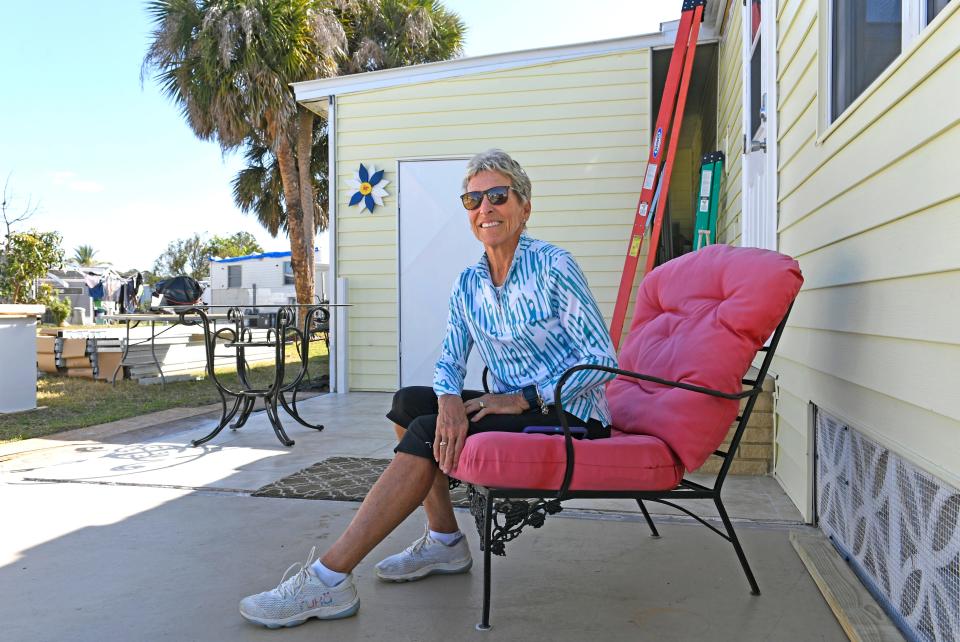
Armstrong said the park is slowly rebuilding.
“Some people chose not to come back because of the state of the park,” she added.
An upgrade to the main clubhouse, planned just prior to Ian, deprived residents of a key sense of community.
“We’ve been anchorless,” Armstrong said. “When you don’t have a clubhouse to meet and have parties and card games and all that kind of stuff, it changes the dynamics of the park.
“But we’re muddling through it. We’re using our other, smaller clubhouse, we're having outside dances, we’re still having picnics and other activities – it’s just not quite the same.”
Armstrong, who still has her home in Nova Scotia, marveled at how her neighbors who live at the park full time have handled the rebuilding.
“I guess sometimes people’s resilience surprises you and it’s a pleasant surprise,” she said. “People are upbeat; they’re hoping Holiday Park can bounce back out of this and move forward. That’s all we can hope for.”
Lee County hit hardest
Lee County and its coastal communities of Sanibel Island and Fort Myers Beach were the hardest hit, as 97,950 households have received $450 million in individual assistance and $2.1 billion in flood insurance payments made on 27,000 claims.
About 26,970 households in Charlotte County – essentially due east of Cayo Costa where Ian's eye came ashore, received $90 million in individual assistance and $43 million was paid out for 2,000 flood insurance claims.
In comparison, 26,000 households in Sarasota received $77 million in assistance and $48 million in has been paid in 1,250 flood insurance claims. In Manatee County $17.3 million in assistance was doled out to 11,887 households and $1.2 million in flood insurance payments were made on about 100 claims.
For DeSoto County, $23 million in assistance was paid to 4,600 households and $7.9 million in flood insurance payments were made on 140 claims.
After North Port's flooding
For much of North Port, the combination of heavy rain and subsequent rising waters of the Myakka River did as much or more damage than Ian's winds.
The Myakka River at Myakka State Park reached a new record flood stage at 12.8 feet, shortly after midnight, Oct. 1. That, combined with 21.45 inches of rainfall, led to severe flooding in the city of North Port – especially in North Port Estates.
Related:Extreme water flow from Ian led to erosion of the banks of a key North Port drainage canal
The increased volume of water flooded previously dry areas such as Country Club Ridge, north of the Cocoplum Waterway and east of McKibben Park, and eroded the north bank of the waterway at Water Control Structure 106.
North Port Estates residents Wesley Mauger and his partner, Danielle Leonard were whisked away from their flooded area by civilians in airboats on Sept. 30 and briefly stayed with relatives in St. Petersburg.
“Everything has been repaired out here,” Mauger said. “Everybody is still putting their houses back together.”
Mauger said his situation was settled through his insurance company and did not require FEMA assistance. “I was fortunate,” he added.
Related:FEMA rule could mean many can't afford to rebuild after Hurricane Ian
Ken and Linda Mosser and their family, who live close to the center of city, a few blocks east of the Myakkahatchee Creek, were rescued by first responders on airboats as flood waters rose in the first few days after Ian.
They too are back home.
“We’re just trying to put our place back together,” Ken Mosser said.
Mosser have found the recovery frustrating, after trying to get help from FEMA without success.
“For each thing it was like, you make too much, you make too little … you have insurance,” Mosser said. “And insurance told us to call FEMA.”
“We have a roof over our head and food in our belly and we’ll be OK,” he added. “There’s a lot of people worse off than we are.”
The Mossers live with her parents and their daughter and grandkids came to the house after the storm.
“We were blessed,” he added. “No one was hurt, nobody drowned or got stuck in the house.”
No thanks, Ian, from Englewood
The words written on what had once been a little slice of paradise for Michigan snowbirds Sue and Steve Lesky are hard to miss: “Thanks Ian. Not.”
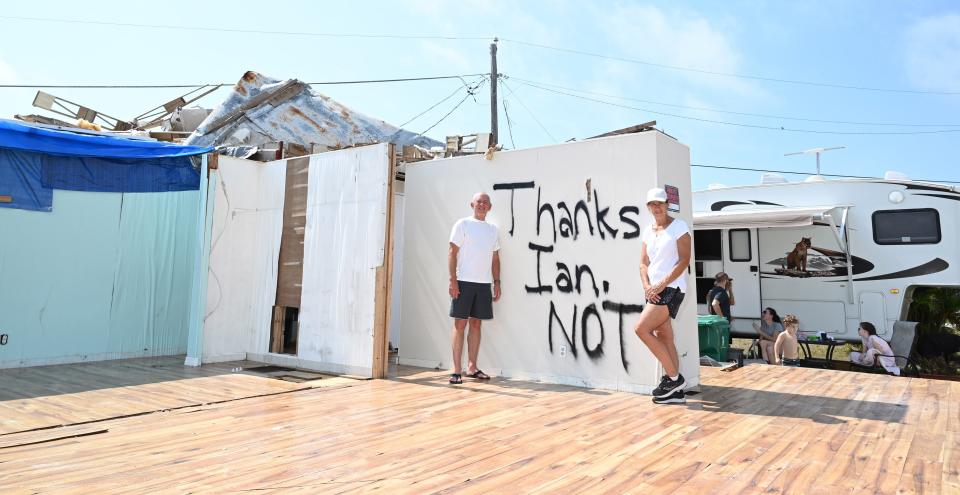
“This is our house, what's left,” Sue Lesky said as she stood beside what had once been the kitchen of their home away from home on Moss Drive, a few blocks west of Placida Road in the Englewood area.
The front wall fell in, one side wall fell out and winds from Hurricane Ian peeled most of the roof off, “like a sardine can, it just rolled back” Lesky said.
“We found our kitchen light back there,” she added, pointing over her shoulder to an adjacent yard.
Steve Lesky noted they had to take a chainsaw to some of the walls to salvage stuff.
Last April they had completely remodeled inside their home – new kitchen, new windows, a new wooden floor and a fresh coat of paint.
“It got done last April, we went home to Michigan, came down to pick up the pieces,” Steve Lesky said.
The Leskys had no insurance and because they’re snowbirds, do not qualify for FEMA assistance.
“They shut you down first sentence,” Sue Lesky said.
They never got past the first question: Do you live in Florida full time?
Like others in their little neighborhood, behind Lemon Bay Automotive, the Leskys own their land. It consists mostly of manufactured homes but it’s not a formal park.
Some homes were spared, while others were not.
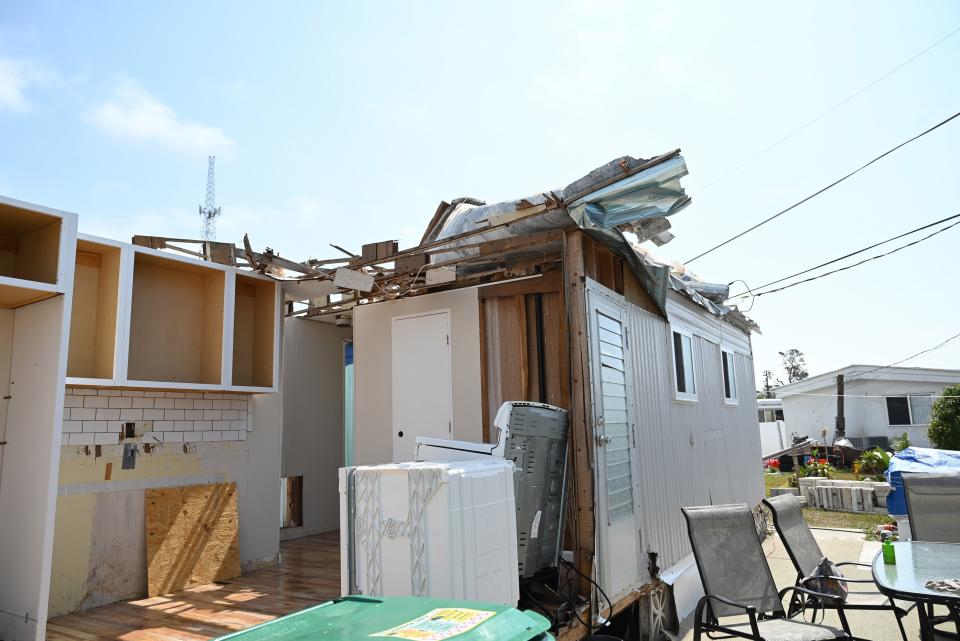
“We think because it was on the north eyewall it was a tornado,” that did the damage,” Sue Lesky said. “Because every house on this side of the street, it came through and it demolished all of these.”
The home of her brother, Rick Blauwkamp, who lives diagonally across the street, came through relatively unscathed. He lost a carport and sheds but sustained no roof damage.
“He got lucky – everybody on that side did,” she added.
After the Leskys learned they could live for up to two years in a mobile home on their property, they purchased a two-bedroom travel trailer in Michigan.
Since then, the Leskys have been staying there, along with her sister Sherry Kloostra and her husband.
At first, they were salvaging what they could from the destroyed home. Both women marveled at the outreach from Charlotte County first responders, the National Guard, volunteer organizations like Samaritan's Purse and even a woman who stopped to offer hot lasagna-style meals she carried in her trunk.
“Faith has paid a big part of how we’re calm with all of this,” Sue Lesky said. “We’re believers and it’s carried us through.”
Still they have yet to decide whether to replace their vacation home or move on.
Sue Lesky said: “They say we can probably get one by January but I already paid for one and I lost it so I’m a little gun-shy.”
“It’s kind of sad,” she added. “We absolutely love Florida.”
Slowly climbing the ladder
When the rising floodwaters of the Myakka River forced Rusty and Jessica Foltz to leave their four-bedroom rental house on Myakka Drive in the Playmore subdivision in south Sarasota County, they were barely able to salvage a couch, a television stand and televisions.
Their bedroom furniture and all of their cookware was ruined.
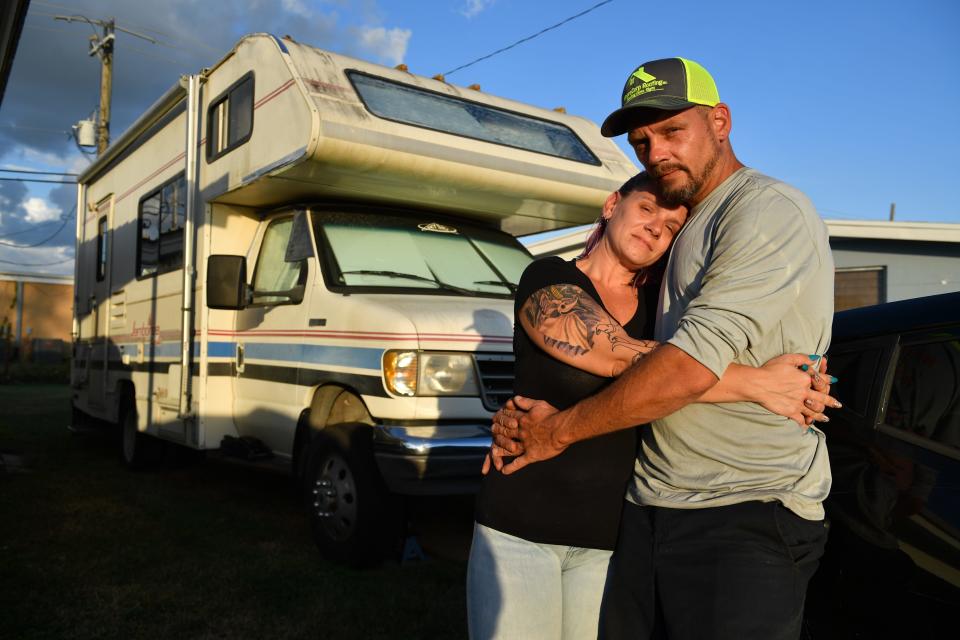
They contacted FEMA and found some immediate financial relief – $4,224 for two months living expenses and an offer to housing assistance for up to 18 months.
That went to pay for temporary rental and to purchase essentials like new pots and pans bought at Black Friday discount prices.
They later moved into a borrowed1994 Jamboree RV, parked in the side yard of the house Jessica’s mother, Adrea Timmins, rents in Port Charlotte.
Before the Christmas break, their daughter, Olivia, 6, stayed with Rusty’s parents – who lived next door off of Myakka Drive – so she could continue at Taylor Ranch Elementary School.
But on Dec. 28, Rusty’s parents, Russell and Diane Foltz, sold their home and bought a new one in Pennsylvania.
Rusty had traded his roofing job in Fort Myers for a job at Snook Haven and was working his way up into management but after several months they still had not found consistent housing and it was taking a toll on Jessica.
“It got to a point where I just looked at him and said, ‘I can’t do this anymore, we’ve done it for five months at this point almost and I’m done,'” she said.
The couple had planned to move to Pennsylvania, to be near Rusty’s parents, but Jessica’s ex – the father of her two eldest daughters – convinced them to give where he lives in Lexington, South Carolina, a try.
The couple is still in the process of appealing FEMA’s reimbursement for personal property.
On March 11 they received a phone call asking them to submit an invoice for what it would take to buy furniture equivalent to what was destroyed in their old home.
“I needed to go to a furniture store and get a quote for all the furniture I needed to replace,” she said. “We found the home that we would put in our home together that was equivalent to what we had and we handed in – it was almost a $25,000 quote.”
FEMA will ultimately cover the family’s moving expenses – on a reimbursement basis with verified receipts.
“We’re still in the same situation; we have to come up with money to get into a place and are still struggling with readjusting,” Rusty Foltz said.
Still both Rusty and Jessica have job prospects, and people they’ve met have been friendly and understanding after hearing their story.
“Here we are hitting the six-month mark,” Jessica Foltz said “We’re not in the best position but we’re climbing the ladder slowly.”
This article originally appeared on Sarasota Herald-Tribune: Area residents still recovering from impact of 'generational storm'

